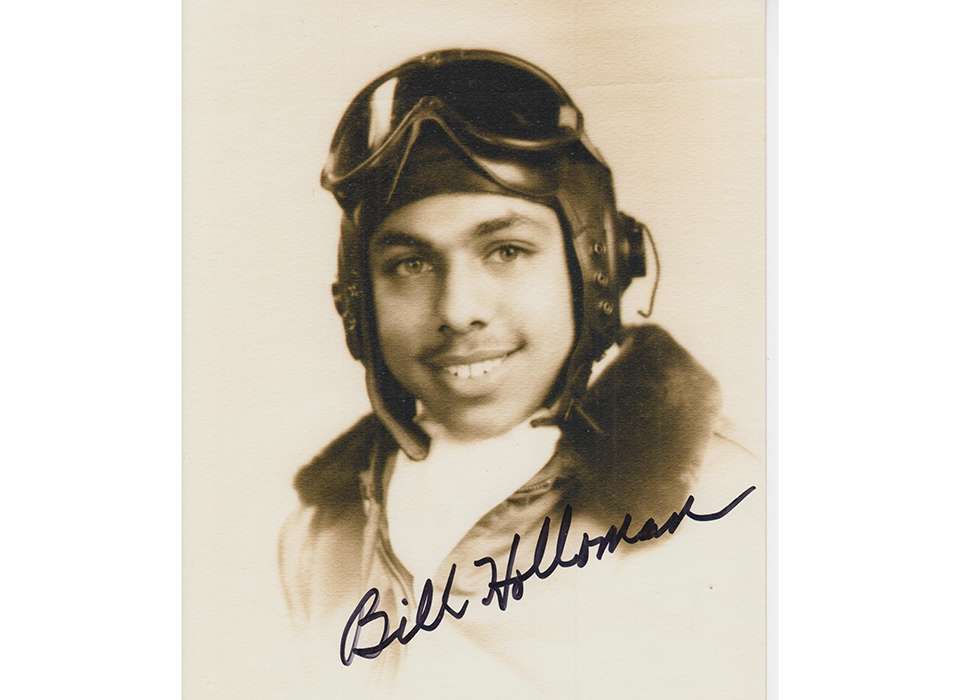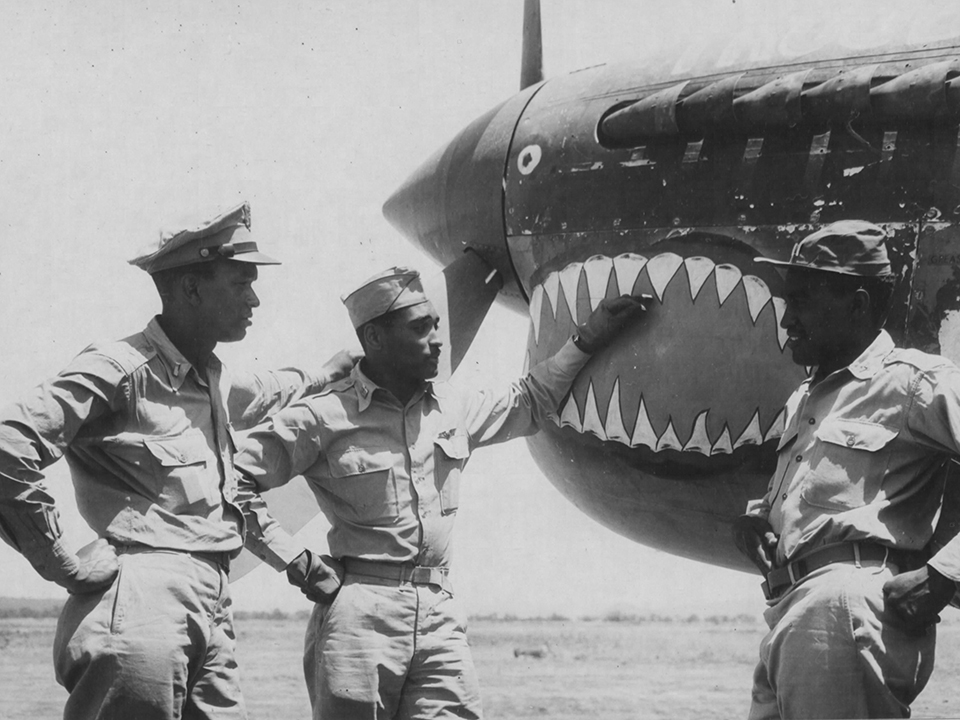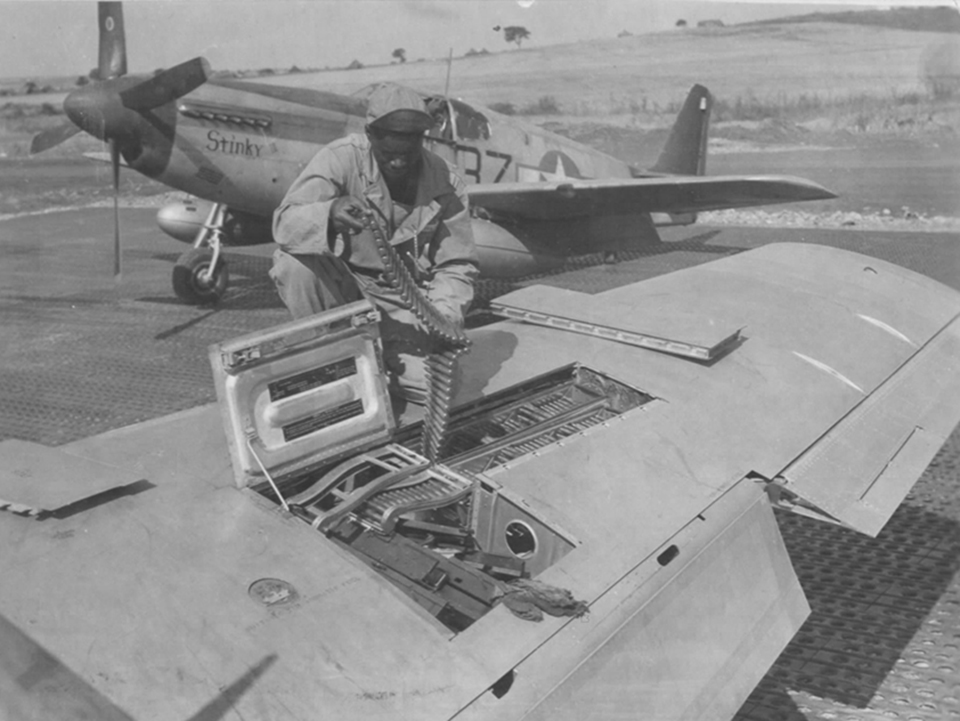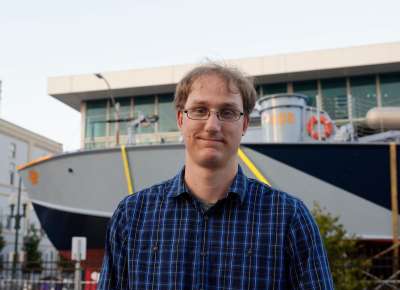William Holloman grew up in a neighborhood in St. Louis, Missouri, where during his early life he really did not experience the segregation that permeated almost all of American society. He recalled, “I guess we had as much discrimination in St. Louis as anyplace, but we were sheltered from it.” He went to the local movie theater, unaware that he was not allowed in the one downtown. He did not go to the local school, not because it was for whites only, but because his grandmother was the principal at another school, making it only natural that he attended her school. His family attended Catholic church with German and Italian families, whose children he befriended, even playing youth baseball with them on integrated teams. The first time he was exposed to the true extent of segregation was after he was commissioned as a Lieutenant in the US Army Air Forces. Home on leave in 1944, he brought a date to the downtown movie theater only to have the teller explain that he could not bring that woman in, it was a whites only theater. Shocked, Holloman responded “I’m not white,” only to be told, well he couldn’t go in either. It was not until Holloman returned to the United States after fighting in Italy that he realized how much he hated the way things were for his race in the United States.
World War II for William Holloman began the same way it did for almost every American, with news of the attack on Pearl Harbor. Hearing about the attack on the radio, his father came in to announce it to the family, and just like many Americans they soon had to get an atlas to look up where Pearl Harbor was. Unable to find it, Holloman kept hearing “Honolulu” and used the city name to finally figure out it was some small island in the Pacific. Suddenly the news became less concerning because it was so far away, until the next day when Congress declared war.
The year before, Holloman had tried to join the Royal Canadian Air Force. Passionate about flying, he applied at the age of 16, but required both parents’ permission to join. His father consented, but his mother refused to sign, saying he was just too young. Holloman would have to wait two years until he turned 18 before joining the military in order to fly. After passing the test to join as an air cadet, Holloman’s USAAF career began to move quickly. First, he was sent to Keesler Filed in Mississippi only to end up with a group of recruits that had not yet taken the test Holloman had already passed. With the help of a cousin, who was a master sergeant, he was bumped up a cadet class and sent to the Tuskegee Institute for a semester. His semester would only last a few weeks as they needed pilots, so once again, he was bumped up to flight training. From then on, he was training, training, training.
L to R. Lt George R. Bolling, Captain Erwin B. Lawrence, and Captian Leon C Roberts, veteran pilots of the 99th Fighter Squadron stand next to a P-40 Warhawk at an airbase in Italy. Courtesy of the National Archives.
The unit Holloman eventually joined in Italy was the 99th Fighter Squadron, 332nd Fighter Group, known as the Red Tails. By the time he had completed training and was deployed it was the beginning of 1945. After training on P-47s in the United States, Holloman had to quickly adjust to the entirely different P-51 when he arrived at the airbase in Ramitelli, Italy. Over the next few months he flew 19 combat missions, ranging from bomber escort to ground attacks, all the time witnessing the loss of friends and experiencing the fear of combat. Even though the bases were segregated, the white bomber pilots often mixed with the members of the 332nd Fighter Group while they were in town on leave. Holloman recalls these times as good, where each man looked at another as brothers in arms fighting for the same cause. He also recalled his experiences under the group’s commander, then Colonel Benjamin O. Davis Jr., a man that took a bunch of young pilots and instilled in them pride as members of the military and representatives of their race.
Private First Class John T. Fields loading .50 caliber machinegun ammunition into the wing of a P-51 mustang from the 332nd Fighter Group, Italy. Courtesy of the National Archives.
At the end of World War II, returning home was hard for Holloman. He faced racism and segregation the moment he stepped off the ship. After all of his experiences overseas he hated to see where American society was. Even worse, the color of his skin prevented him from finding work in the aviation field. Over the next few decades Holloman kept returning to the military because it was the only organization that would let him fly, and each time he returned to the United States he was again disgusted with the society that greeted him. This did not mean he never faced racial boundaries in the service either. Benjamin O. Davis Jr. asked Holloman to return in 1948 to be one of the first members of a fully integrated air force. He fought the good fight, having good and bad experiences, until his retirement in the 1970s. By the time he left the USAF, William Holloman had served in three wars and accrued more than 17,000 flight hours. Holloman was proud of his military service, and was deeply proud of being an American. After his retirement he settled in Seattle, Washington, where he ran a number of businesses and dedicated his life to the study of African Americans’ contributions to the military.
Joshua Schick
Cite this article:
MLA Citation:
APA Citation:
Chicago Style Citation:





![Max Fuchs, New York City cantor, sings as Rabbi Sydney [sic] Lefkowitz, Richmond, VA, conducts the first Jewish services from Germany.](/sites/default/files/styles/max_650x650/public/2025-10/image1.jpg)





